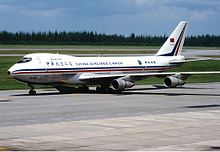China Airlines Flight 358
 B-198, the aircraft involved in the accident, 1985. | |
| Accident | |
|---|---|
| Date | December 29, 1991 |
| Summary | Engine detachment due to improper maintenance |
| Site | Wanli, Taiwan |
| Aircraft | |
| Aircraft type | Boeing 747-2R7F/SCD |
| Operator | China Airlines |
| IATA flight No. | CI358 |
| ICAO flight No. | CAL358 |
| Call sign | DYNASTY 358 |
| Registration | B-198 |
| Flight origin | Chiang Kai-shek Int'l Airport Taipei, Taiwan |
| Destination | Anchorage International Airport Anchorage, Alaska, United States |
| Occupants | 5 |
| Passengers | 0 |
| Crew | 5 |
| Fatalities | 5 |
| Survivors | 0 |
This article needs additional citations for verification. (June 2012) |
China Airlines Flight 358 was a Boeing 747-2R7F/SCD freighter that crashed on December 29, 1991 shortly after takeoff from Chiang Kai-shek International Airport in Taipei, Taiwan.
Aircraft[]
The aircraft was a Boeing 747-2R7F/SCD, built in September 1980 for Cargolux as the "City of Esch-sur-Alzette," registration LX-ECV, MSN 22390. It was acquired by China Airlines in June 1985 was given its registration of B-198. It has been in service for 11 years, 3 months.[1] The aircraft had clocked a total of 45,868 hours of flight time during its time in service. The last A-check maintenance had occurred on December 21, 1991, and the aircraft had accumulated 74 hours of flight time since that point.[1]
Accident[]
Several minutes after takeoff, the crew reported problems with the #2 engine, prompting Taipei air traffic control (ATC) to vector the flight into a left turn to return to the airport. Approximately two minutes later, the crew reported that they were unable to turn left, and ATC approved a right-hand turn instead. This was the last radio contact made by the crew. The crew lost control of the aircraft and it struck a hill, right wing first, near Wanli, Taipei. The crash occurred at approximately 3:05 PM, at an altitude of 700 feet.[1] All five crew members died in the crash, and there were no injuries on the ground.
Investigation[]
The subsequent investigation revealed that the number 3 engine and its pylon had separated from the aircraft and struck the number 4 engine, breaking it off the wing as well.[1] A more detailed investigation revealed that the pylon midspar fittings, which attach the pylon to the lower portion of the wing front spar, had failed.[citation needed] The search for the number 3 engine and its pylon, which landed in the sea, took several months.
Information from the investigation of this crash and the nearly identical crash of El Al Flight 1862 10 months later resulted in Boeing ordering pylon modifications to every 747 in use.[2]
The aircraft was the same one involved in the China Airlines Flight 334 hijacking on May 3, 1986.
Trivia[]
- It was briefly mentioned in the Mayday episode "High Rise Catastrophe" which focused on El Al Flight 1862, but the flight number wasn't mentioned.
See also[]
- Aviation safety – Metal fatigue
- American Airlines Flight 191 – May 25, 1979 – A DC-10 which also suffered a fatigue-induced pylon failure.
- El Al Flight 1862 - October 4, 1992 – Another 747 which also suffered a fatigue-induced pylon failure of almost exactly the same nature; engine number 3 broke off and hit number 4, breaking it off as well.
- Trans-Air Service Flight 671 - a similar failure of an engine pylon on a Boeing 707, resulting in the loss of both engines on the right-hand side; although the pilots were able to land safely, the aircraft was damaged beyond repair.
- Reeve Aleutian Airways Flight 8
References[]
- ^ Jump up to: a b c d Accident description at the Aviation Safety Network
- ^ "Aircraft accident report 92-11 : El Al Flight 1862 Boeing 747-258F 4X-AXG Bijlmermeer, Amsterdam 4 October 1992" (PDF). Nederlands Aviation Safety Board. 24 February 1994. Archived from the original on 26 June 2008.
- Airliner accidents and incidents caused by in-flight structural failure
- Airliner accidents and incidents caused by mechanical failure
- Airliner accidents and incidents caused by maintenance errors
- Accidents and incidents involving cargo aircraft
- Accidents and incidents involving the Boeing 747
- Aviation accidents and incidents in 1991
- Aviation accidents and incidents in Taiwan
- China Airlines accidents and incidents
- December 1991 events in Asia
- 1991 in Taiwan